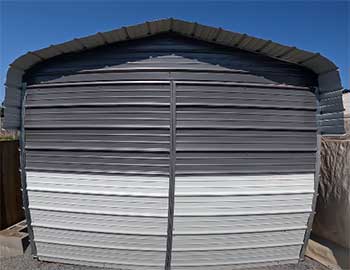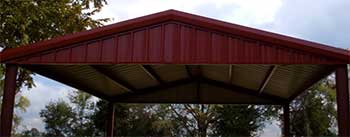Planning the construction of a structure can be a long, drawn-out process. One of the main factors to consider is what material to use to build the framework of the structure. Two very popular materials are VersaTube and Red Iron.
Though they are used for similar purposes, they have a few very distinct differences. The main one is that VersaTube is used mostly for smaller projects, while Red Iron is more used for large-scale industrial construction.
Let us go ahead and discuss all these differences.
A Brief Comparison Table
| Specification | VersaTube | Red Iron |
| Components | High-quality steel, with a triple coat of corrosion protection | Steel sprayed with red iron oxide. |
| Resistance | Rust, termite, and fire resistant | Rust, termite, and fire resistant |
| Uses | Smaller scale projects | Larger-scale industrial projects |
| Ease of Use | Easy to build and great for DIY projects | Requires professional help to put together |
| Cost | Comparatively less expensive | Expensive to buy and assemble |
Key Differences Between VersaTube And Red Iron
After going through the table provided above, you should now have a brief idea about each characteristic and difference between VersaTube and Red Iron.
Now, let us go into more detail and break down and discuss each and every difference mentioned in the table.
- Components

An important part to consider when thinking about building materials.
The framework of a building is what keeps everything else together.
So, it is imperative that you choose the strongest material possible for it.
Both VersaTube and Red Iron are made from good, high-quality steel.
Thus, they are ideal for most kinds of construction projects.
VersaTube steel frames are made with high-quality steel. They are then coated with a triple layer of corrosion protection.
This protective layer adds strength and provides resistance against rust, adding years of life to the building.
Red Iron, like VersaTube, is also made of high-quality steel. To get the eponymous red coloring, the steel is then sprayed with red iron oxide.
This not only gives Red Iron its distinctive red appearance, but it also acts as a protective layer for the steel against water and rust.
Being made of steel also makes both materials environmentally friendly. Wooden frames are not only expensive but also come at the cost of many trees being felled. That is not the case with steel, as it is cheap and readily available.
Aside from that, once the structure reaches the end of its life, the steel will not end up in a landfill somewhere. Instead, since steel is the most recycled material on the planet, it will be reused to create something new.
Another benefit to using steel-based frameworks such as VersaTube or Red Iron is their insulation and resistance to the elements.
Wooden frames, for example, are not as resistant to nature as steel. Wood expands and contracts based on the weather. This causes cracks and splinters in the material or creates gaps in the structure.
But steel does not have this issue. It holds strong against every kind of element.
- Resistance
Any sort of building is expected to last for a long time. This means it is very important for the building to have a durable framework that is resistant to the different elements and other potential sources of damage, such as termites and rust.
VersaTube’s being made from high-quality steel means it is fireproof and immune to termite damage. On top of that, the triple coating of corrosion protection adds resistance against rust.
Just like VersaTube, Red Iron is also made from good-quality steel and is fire- and termite-proof. Along with that, the added layer of iron oxide acts as a barrier, protecting the steel underneath against water and rust.
However, Red Iron is a strong conductor, making it vulnerable to heat and cold.
- Method of Usage

This is where the biggest difference lies between VersaTube and Red Iron.
Though made of the same base material and having a few similar characteristics, the ways they are used are vastly different.
VersaTube is mostly used for small-scale operations and projects. Structures such as sheds, carports, garages, small storage areas, and other small buildings are ideal for being built using VersaTube.
Moreover, VersaTube’s being pre-engineered into individual pieces that fit together, makes it perfect for personal and DIY projects.
On the other hand, Red Iron is widely used as a framework for large-scale industrial structures. Buildings such as farms, warehouses, industrial plants, factories, office buildings, and large storage areas are frequently built using Red Iron frameworks.
Unfortunately, this makes Red Iron difficult to use for personal projects. Trained professionals are required to put together structures using this material.
- Ease of Use
As mentioned before, VersaTube is manufactured to be as beginner-friendly and easy to use as possible. The pieces are prefabricated, fit together, and do not require heavy industrial tools to put together.
Because of this characteristic, anyone with basic construction knowledge can easily build small structures easily using VersaTube.
However, Red Iron is mostly a construction material used as a framework for heavy, large-scale projects. While it is not suitable for personal projects, it is widely used in the construction world, making it very familiar to professionals.
- Cost
The final and arguably one of the more important differences between the two. VersaTube by itself is relatively cheap compared to other materials.
On top of that, the fact that it does not require professional aid, or any heavy-duty tools makes it even cheaper overall.
Red Iron is a more expensive material than VersaTube. Add in the extra cost of needing professionals to install and put it together, and it makes it significantly more expensive than VersaTube.
Which Material Should You Use?
In the beginning, you may have been stuck making a decision between VersaTube and Red Iron. After the discussion, we can come to a definitive conclusion.
For small-scale and DIY projects, VersaTube is far more suitable. But if it is a large-scale industrial structure, Red Iron should be chosen instead. Here is how to build a Red Iron carport.
Frequently Asked Questions (FAQ)
Below are some frequently asked questions and their answers.
VersaTube makes for good carports as it is durable, easy to assemble, and relatively inexpensive.
The quality and corrosion protection of VersaTube, along with its manufacturing method, makes VersaTube buildings strong and long-lasting.
Red Iron is heavier and stronger than steel, but also more vulnerable to rust.
VersaTube is made of 14-gauge steel tubing.
Final Words
Both VersaTube and Red Iron have their respective places in construction. The former is relatively inexpensive and easier to use, even with minimal construction knowledge, the latter is heavier and stronger but requires professional help to put together.
In the end, the material you choose depends on your project. Hopefully, this article on VersaTube Vs. Red Iron helps you make that choice.
